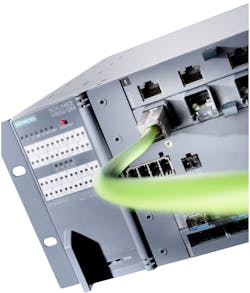Is Your Network Ready for the Future?
Whether or not you’re fully onboard with the big technology trends sweeping across industry—such as the Industrial Internet of Things, Big Data, and cloud computing—your automation technologies are likely in need of an upgrade. Doing so is not just a matter of keeping up with Joneses; it’s about staying relevant in an increasingly digitized industry.
No matter which direction your upgrades may ultimately lead, the key place to start your journey is with your industrial communication network. After all, your network is the basis that will impact—in terms of scalability and flexibility—any future hardware or software upgrades.
A recent discussion with Andreas Rehm, product manager with Siemens, focused on the essential aspects of a modern industrial network. Before getting bogged down in the specifics of communication protocols, physical layer attributes, or data speeds, Rehm suggests taking a higher-level view of your network in light of overall business needs.
“It is essential to carefully design your network,” Rehm says. “After all, if a flat network grows unimpeded, it soon reaches an extent where errors can be passed on to a large part of the plant. Modifications then become very time-consuming and costly.”
To approach your network design in the best possible way, Rehm suggests careful consideration of four main issues that impact industrial network support of production operations and the business as a whole. Those issues are: the coupling of IT and automation; a holistic perspective to the selection of components and security; protection through redundancy; and network transparency and diagnostics.
Coupling of IT with automation
These two areas of every manufacturing business have different perspectives that are illustrated in the fundamentally different network components and topologies deployed in the two areas. Despite these differences, the push toward digitalization across industries means that the networks of both areas must be reviewed.
“Devices employed should support the necessary mechanisms and protocols needed for production,” Rehm says. “However, they also have to be suitable for IT.” As an example of this, he cites the need for support of command line interfaces or the support of 10 GB transmission rates for devices on the border of IT and production networks.
Holistic selection of components & security
Despite increasing cost pressures and long-held industry practices of purchasing on price, Rehm says that the digitalization of industry necessitates a more holistic approach. “Added value created by technology cannot be nominally compared through sale price alone,” says Rehm. “The interaction of different components, consideration of environmental conditions, possibilities for energy savings, and the need for high availability are all attributes that can bring about enormous savings over the years, but are often not fully apparent at the point of sale or beginning of the project.”
Applying a holistic approach to security is equally beneficial, contends Rehm. “Industrial control system and network security is multilayered and complex,” he says. “Data security not only has to be planned well, but also consistently practiced by the user.”
He suggests leveraging the expertise of external companies when it comes to security to ensure that any developed policies and procedures are not affected by a company’s own “operational blindness.”
Protection through redundancy
Because faults are possible even in the most perfectly planned networks, protection for the operator can be gained by installing corresponding redundancy mechanisms, which enable the industrial network to cope with the failure of a component or cable without affecting the communication.
“As components often already support a number of redundancy protocols, redundancy does not have to mean higher investment costs,” Rehm adds. “However, since redundancy can be implemented in a variety of ways, care should be taken to design it according to your network requirements. The critical paths of network communication should be considered which, in case of a failure, could cripple the communication flow and thus shut down the production.”
Transparency and diagnostics
Industrial networks are constantly being expanded either by adding on devices or linking existing islands with each other, notes Rehm. “As a result, constant and thorough documentation of your network situation becomes an important task which cannot be adequately performed manually,” he says. “Thankfully, this task is assumed by modern network management systems which monitor and document the industrial network structures including all necessary identification and maintenance data.”
Due to this type of automatic record keeping of network data, weak points in the network can be quickly located and networks can be more easily expanded and optimized.
Rehm notes here that diagnostics is often perceived as a financial burden, since it doesn’t initially represent an added value to the production process. However, the benefit of diagnostic tools can be financially measured when downtimes in the industrial network have been reduced or even prevented. As a result, diagnostic tools that continuously monitor the network are fast becoming considered to be almost indispensable. With this level of insight, “problems can thus be corrected before they lead to a failure,” he says.
To ensure that your network transparency and diagnostic capabilities are fully facilitated, Rehm says it is important “to use tools that can be integrated into your existing HMI/SCADA landscape. Only then can it be ensured that messages or fault notifications are not lost or noticed too late.”

